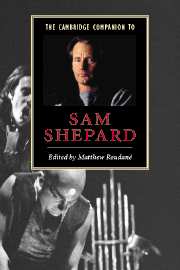Book contents
- Frontmatter
- Introduction
- 1 Born injured
- 2 Shepard and Off-Off-Broadway
- 3 Shepard on Shepard
- 4 A note on Sam Shepard
- 5 Joseph Chaikin and Sam Shepard in collaboration
- 6 Repetition and regression in Curse of the Starving Class and Buried Child
- 7 Shepard writes about writing
- 8 Reflections of the past in True West and A Lie of the Mind
- 9 Patriarchal pathology from The Holy Ghostly to Silent Tongue
- 10 The classic Western and Sam Shepard’s family sagas
- 11 European textures
- 12 Sam Shepard and the cinema
- 13 Sam Shepard as musical experimenter
- 14 Sam Shepard’s nondramatic works
- 15 States of Shock, Simpatico, and Eyes for Consuela
- 16 Sam Shepard’s The Late Henry Moss
- 17 Sam Shepard
- Select bibliography
- Index
7 - Shepard writes about writing
Published online by Cambridge University Press: 28 May 2006
- Frontmatter
- Introduction
- 1 Born injured
- 2 Shepard and Off-Off-Broadway
- 3 Shepard on Shepard
- 4 A note on Sam Shepard
- 5 Joseph Chaikin and Sam Shepard in collaboration
- 6 Repetition and regression in Curse of the Starving Class and Buried Child
- 7 Shepard writes about writing
- 8 Reflections of the past in True West and A Lie of the Mind
- 9 Patriarchal pathology from The Holy Ghostly to Silent Tongue
- 10 The classic Western and Sam Shepard’s family sagas
- 11 European textures
- 12 Sam Shepard and the cinema
- 13 Sam Shepard as musical experimenter
- 14 Sam Shepard’s nondramatic works
- 15 States of Shock, Simpatico, and Eyes for Consuela
- 16 Sam Shepard’s The Late Henry Moss
- 17 Sam Shepard
- Select bibliography
- Index
Summary
Because he uses theatrical techniques that have been identified with postmodern theatre, Sam Shepard is often written of as a postmodern playwright. Certainly his theatrical techniques have much in common with those of the postmodern theatre. His stage reality is layered and fragmented, his characters sometimes intersubjective and transformational. He juxtaposes borrowings from and allusions to popular culture with those of history and high culture in an often free-form, playful way. He often uses sets that call attention to the theatre's existence as theatre, and invites acting techniques that call attention to the actor as performer and the play as performance. All of this Shepard shares with his postmodern contemporaries. His conception of the playwright's art, however, is far from the distant, ironic stance of the postmodern artist. In fact, as Michael Early has pointed out, Shepard has a great affinity with the American Romanticism of nineteenth-century Transcendentalists like Emerson and Whitman. Unlike theirs, however, Shepard's is a dark Romanticism, closer to the Gothic imagination of Poe or the cosmic despair of Melville than to the Transcendental optimism of Emerson or Whitman. What he chiefly has in common with the Romantics is his sense of the artistic imagination, his awe for his own gift and his compulsion to understand it.
- Type
- Chapter
- Information
- The Cambridge Companion to Sam Shepard , pp. 123 - 138Publisher: Cambridge University PressPrint publication year: 2002
- 3
- Cited by



